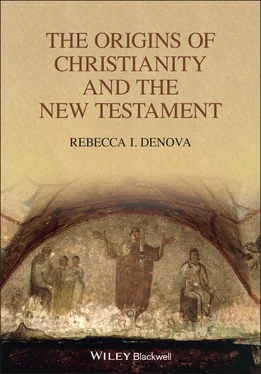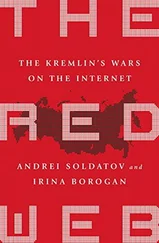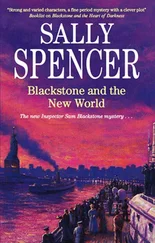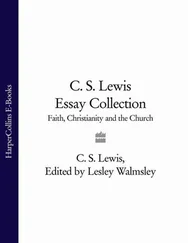The details of Paul’s communities in Chapter IX (“Paul and the First Christians”) shed light on the first generation of Christians. We can appreciate some of the confusion of the first followers, as they were to live “like angels” until the return of Christ.
The other letters in the New Testament are examined briefly in Chapter X (“Other New Testament Documents”). They reveal changes in the communities from the middle to the end of the first century. These letters include a group known as “The Pastorals,” as they outline the initial hierarchy and structure (the election of bishops) and what became the institutional Catholic Church of the Roman Empire.
We end where the New Testament ends, with “John of Patmos and the Book of Revelation” in Chapter XI. One of the most famous (and infamous) books, the book still dominates Christian concepts of the return of Jesus (the “second coming”) and events that are to happen in “the final days.” The chapter provides a way in which to “decode” this strange book and the way in which to understand its symbols in historical context.
Each of the chapters places the documents within their historical context and highlights changes to the material over time.
Understanding the background and nuances of ancient texts requires years of study and analysis. Rather than burden the reader with the details of scholarly expositions and debates, Boxes are provided in the chapters that summarize issues or add detail to the background; for example, “Hell and Heaven” and “Jewish Sects in the Second Temple Period”.
Figures and Timelines appear within the chapters and highlight maps, schematics, and some of the archaeological sites associated with the New Testament. I have traveled to and explored all these sites. When appropriate I add a few details to each place.
Understanding both the world of ancient Christianity as well as scholarly methods of analysis often requires a vocabulary not familiar to the lay reader. Throughout the text, words and concepts will appear in bold printand are then defined in a convenient Glossaryat the end.
Each chapter contains “Suggestions for Further Reading” for those who wish to explore the material in depth. The Suggestions include both traditional studies and more recent articles and books.
I have taught a course on the “Origins of Christianity and the New Testament” for over twenty-five years. Some students enter the course with more background than others, usually from Bible Study programs in their churches. In the beginning there is often some anxiety over the fear that a historical approach to Jesus will uncover something that will challenge their faith. “Faith” by its very nature is not subject to verification or scientific analysis. This text is not designed to challenge anyone’s faith – it is to provide an understanding of how that “faith” originated in the first century.
Like trying to “prove” that God created the world in six days, similar attempts to “prove” that Jesus is the savior of the world fail on equal terms. Rather, what this text attempts to do is explore why Paul, Mark, Matthew, Luke, and John believed he was the savior of the world (and what that meant to them). Theirs is our only historical evidence. Some facts will surprise readers; contrary to Renaissance and modern art, Jesus did not have blond hair and blues eyes. However, there is nothing in the text that will diminish the overall message and traditional teachings of Jesus.
I STUDYING THE HISTORICAL JESUS
Who was Jesus of Nazareth?
Concepts and Terminology
Religion
Polytheism and Monotheism
Myth
Acts of Worship/Rituals
Cult
Gentiles and Pagans (Problematic Terms)
Conversion
Old Testament/Jewish Scriptures
The Problem of Anachronism
Creative Writing
The First Quests for the Historical Jesus
Albert Schweitzer (1875–1965)
Second Quest
The Third Quest
E. P. Sanders
A Fourth Quest?
After reading this chapter, you will be able to:
Appreciate concepts and terminology in the study of ancient religions.
Identify the different phases in the “Quest for the Historical Jesus.”
Distinguish the modern analytical tools applied to the origins of Christianity and the New Testament.
Who was Jesus of Nazareth?
There is an old hymn that used to be taught to children, “Yes, Jesus loves me, for the Bible tells me so.” This sufficed for centuries, but beginning with the Enlightenment, people began to question what is written in the Bible, and the age-old conviction that it was “the word of God.” In the past 200 years, scholars, historians, and, yes, theologians have explored new approaches to uncovering the history of the Bible and how it came into existence.
Nowhere is this more evident than in the hundreds of books in the past seventy years exploring what is termed “the quest for the historical Jesus.” At the center of this quest is the (belated) scholarly discovery of “Jesus the Jew.” Centuries of Christian theology presented him as the first “Christian” and the founder of a new religion. If we strip away this later theology, we can discover the story before there was the “church.” Jesus was a Jewish apocalyptic prophet who lived and preached in the Roman Imperial province of Judea in the first century ce.
This book is about the ways in which modern scholars go about illuminating “the historical Jesus” and the various ways in which his followers proclaimed his teaching in the cities of the Roman Empire. Our sources for the story are in the New Testament. The New Testament was not officially “validated” until a few centuries later, but it contains our primary information for the origins of what eventually became the religion of Christianity.
Surveys on the history of early Christianity number in the hundreds. Most of them, however, spend an inordinate amount of time in scholarly debate, utilizing jargon invented by academics. A goal of this textbook is twofold: (i) to provide the basic understanding of the historical context of the ministry of Jesus; and (ii) to provide a guide for both interested lay readers and undergraduates studying the history of Christianity. Understanding the “origins” of the past elucidates continuing modern concepts and beliefs and their continuing viability in a changing world.
Before we begin, there are several concepts and terms that are utilized throughout the book. Listing them at the beginning helps to avoid repetition in each chapter.
In the modern world, identity is often categorized by a specific religion (Jewish, Christian, Muslim, Hindu, etc.). What we mean by these terms is a “system of belief” that includes concepts, rituals, and social codes. But in the ancient world, the concept of “religion” as a “system” did not exist in the sense that we understand it today. In fact, there was no word for “religion” in ancient Greek or Hebrew. The modern term, which came into use in the seventeenth century, derived from the Latin root religio, sometimes translated as those things “that tie or bind one to the gods.”
All ancient peoples believed in the total integration of the divine(the gods, the powers in the heavens and under the earth), with humans and everyday life. If you stopped someone on the street and asked them what “religion” they practiced, they would have no idea what you were talking about. Instead, the question should be “What customs do you live by?” The typical response would be “The customs of our ancestors.” These customs were what identified people as ethnic groups, with a common ancestor, history, homeland, language, rituals, and mythology. All these elements were handed down by the gods and provided the basis for the governing authorities, the social construction of gender roles, and appropriate codes of behavior.
Читать дальше












